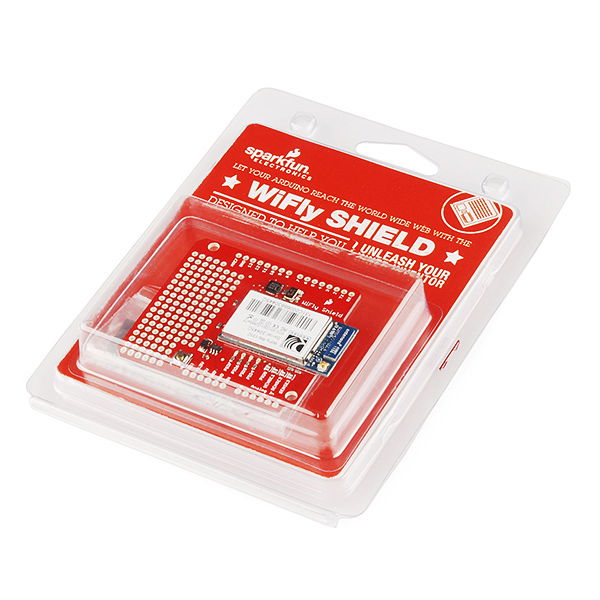WiFly Shield Retail
This is the same product as the WiFly Shield. The difference is this version comes in fancy clamshell packaging meant for our distributors that need it. Regular customers are welcome to order, but we want to limit the amount of extra packaging finding its way into the trash heap.
The WiFly Shield equips your Arduino the ability to connect to 802.11b/g wireless networks. The featured components of the shield are a Roving Network's RN-131C wireless module and an SC16IS750 SPI-to-UART chip. The SPI-to-UART bridge is used to allow for faster transmission speed and to free up the Arduino's UART.
Power is taken from the Vin pin of your Arduino, regulated to 3.3V, and provided to both the RN-131C and the SC16IS750. You'll communicate with the WiFly Shield over SPI using Arduino digital pins 10-13 (CS, MOSI, MISO, SCLK respectively).
The shield includes the RN-131C, SC16IS750 and their supporting components. The shield also provides a small prototyping area, with 0.1" spaced holes. Stackable headers are provided but not soldered on.
- WiFly Shield
- 2x 6-pin stackable headers
- 2x 8-pin stackable headers
WiFly Shield Retail Product Help and Resources
Core Skill: Soldering
This skill defines how difficult the soldering is on a particular product. It might be a couple simple solder joints, or require special reflow tools.
Skill Level: Rookie - The number of pins increases, and you will have to determine polarity of components and some of the components might be a bit trickier or close together. You might need solder wick or flux.
See all skill levels
Core Skill: Programming
If a board needs code or communicates somehow, you're going to need to know how to program or interface with it. The programming skill is all about communication and code.
Skill Level: Competent - The toolchain for programming is a bit more complex and will examples may not be explicitly provided for you. You will be required to have a fundamental knowledge of programming and be required to provide your own code. You may need to modify existing libraries or code to work with your specific hardware. Sensor and hardware interfaces will be SPI or I2C.
See all skill levels
Core Skill: Electrical Prototyping
If it requires power, you need to know how much, what all the pins do, and how to hook it up. You may need to reference datasheets, schematics, and know the ins and outs of electronics.
Skill Level: Rookie - You may be required to know a bit more about the component, such as orientation, or how to hook it up, in addition to power requirements. You will need to understand polarized components.
See all skill levels
Comments
Looking for answers to technical questions?
We welcome your comments and suggestions below. However, if you are looking for solutions to technical questions please see our Technical Assistance page.
Customer Reviews
No reviews yet.




According to the data sheet, it draws 210mA on Tx. Can the Arduino support this?